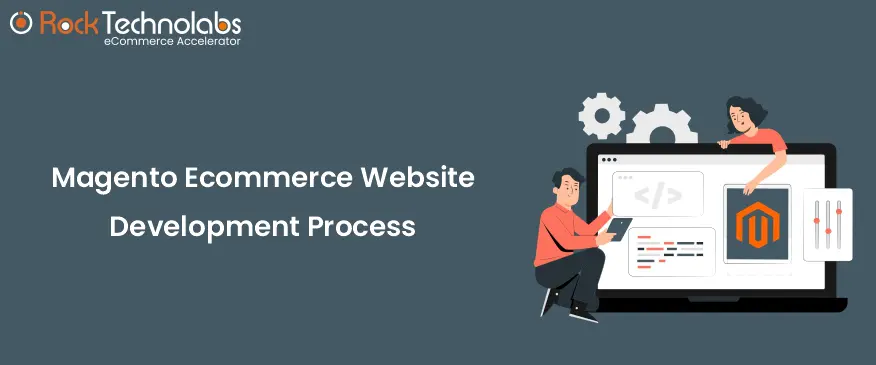What Steps Are Required For The Magento Ecommerce Website Development Process?

Magento, an open-source ecommerce platform, offers online merchants complete flexibility by giving them easy manage shopping cart system. This flexibility makes the customers’ journey easy. The online merchants get functionality and control of the online digital store.
Moreover, Magento eCommerce development allows online business owners to manage various digital stores from a single dashboard. Previously, we had discussed Magento 2 features that makes it preferable choice among retailers.
So, when is the best moment to start developing a Magento e-commerce website? It’s now or never! While you’re pondering how to set up and launch a Magento store quickly, we’ve already produced an informative step-by-step tutorial for you.
Let’s have a closer look at Magento website development process.
1. Perform a business analysis
Every company has a unique narrative to tell. Your target market and audience are likewise quite particular. As a result, our initial step is to familiarize ourselves with your company strategy, clients, target audience, and distribution methods.
The more information we have about your company, the more successful the creative process.
During this time, it is critical to have open lines of communication.
It is one of the most crucial aspects. If there are no unanswered questions, we have a reasonable probability of creating a website that meets its objectives.
2. Analysis of requirements
Make a list of your website’s requirements, which should include:
- Sitemap
A sitemap or structure diagram shows how a website is organized. In the sitemap, which pages are included? For example, the home page, category pages, product pages, shopping cart page, checkout page, CMS pages with information about, contact, FAQs, refund policy, and cookies policy. - Design
There are two ways to build a website: utilizing pre-made themes or designing a custom layout from scratch. If you want to use a pre-built theme, list your customization requirements. Consider your necessary website color, style, or the preferred website you desire for your website while developing it from the ground up. - Function
It is essential to understand kind of functionalities is required whether default or custom, it totally depends on the requirements. - Extension
In order to serve your customers in a better way, it is essential to make use of extensions in a smart way. The use of extensions further helps in boosting performance and makes the user experience better. Define which features should be added, then identify the suitable extension with any customizations needed. - Payment
What payment gateway will the website utilize, and what payment methods will it accept? Is Magento compatible with those payment gateways and methods? If not, what is the best way to integrate (through an extension or bespoke module development)? - Shipping
The big question is which support carrier is easily compatible with Magento. Moreover, how the integration process will work in accordance with the extension and the new module. - Language and money
What are the site’s languages and currencies? Which currency will be utilized to make the transaction? - Integration with third-parties
Is it necessary to integrate the site with a third-party service? (For example, ERP, CRM, PIM) - Timeline and milestones
What is the projected time for the project’s milestones? - Server
There are various servers available, but still one needs to check which server is highly compatible. Usually, Magento supports Nginx & Apache.
3. Web Development (Front-end Development)
- Theme
When planning to build a website, one gets the choice to either pick a free theme or a premium. Apart from that, you should have the logo, banners, and brand colors. - Designing from the ground up
In this case, the web designer will present you with 1-3 website designs (wireframes/prototypes) from which to pick. The frontend devs will begin working after receiving permission. The average period is predicted to be between 1-2 months. - Development of the backend
This step can be completed concurrently with frontend development. Backend development entails the following: - Enable Magento 2’s default features.
The features are set up to work the way you want them to and improve site speed for more sales. - Create your functions (if any)
Backend developers will create bespoke functionalities if necessary. Keep in mind that the more bespoke pieces they need to develop, the longer it will take to develop. - Configure and install Magento 2 extensions
You’ll collaborate with the technical team to create a list of extensions and track down the precise ones. There are a lot of Magento 2 extensions that can help you improve the speed of your site. - Connecting the site to the payment gateway(s) of choice and the shipping carrier’s system
These two are a must-have for any online shop. Developers can propose acceptable currencies or design one for your store based on your area and accepted currencies. - Change the site’s language, currency, shop information, and email templates, among other things.
Developers will finalize the setup for these functionalities when creating the backend. - Integrate third-party applications (if any)
For better management, your company may require an ERP or CRM. It is necessary to notify your development partner as soon as possible so that they may begin working on it. - Import product information (categories, photos, SKUs, descriptions, quantity, and price, for example).
All of your data is imported into the database after the significant pieces have been constructed. - Develop CMS pages
CMS pages are critical for engaging and persuading consumers to check out and buy your items, so take the time to provide them with helpful content.
4: Evaluation
Internal testing and user acceptability testing are two ways that may be used:
- Internal evaluations
The development team’s tester will test each step of the project based on the project’s requirements and the company’s accessible list of test cases. - Acceptance testing for users
You, the site owner, will personally test the final product. You must provide feedback to the development team, including any problems or ideas for improvements.
5: Site Enhancement
At this point, the developer will address the input and, if necessary, enhance speed, performance, and SEO. The developer will email the site to the site owner for approval before launching it.
Double-check everything. Rechecking all binding sites and functionality is never a waste of effort.
6: Launch & Deployment
Code will be deployed or transferred from the development site to the LIVE site on the LIVE server following the development process step. The site will be linked to the domain of the site.
Finally, marketing campaigns are created to draw clients to the new site or other marketing initiatives.
7: Website upkeep and assistance
It would help if you remained in touch with the developer during the release stage (approximately 1 to 3 months) of establishing a Magento website to obtain support when the website has difficulties or help administer the website.
Working with an agency that provides free assistance during the first several months following launch is beneficial.
Which Magento Ecommerce Website Development Company Should You Hire?
Setting up an e-commerce website is a complex undertaking, mainly if Magento technology is used. We, the team at Rock Technolabs can surely help you with full magento development process. If you want to grow your business faster, finding the correct partner to help you with Magento website development is crucial. Need support or consultant for your Magento 2 store? Get in touch.





